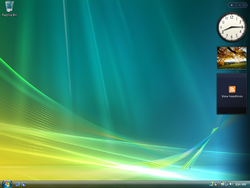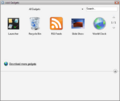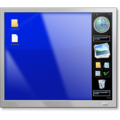Windows Sidebar
| Component of Microsoft Windows | |
 Windows Vista's desktop showing the Sidebar | |
| File name/executable | sidebar.exe (build 5212 and later) |
|---|---|
| Introduced in | Windows Longhorn build 3683 |
| Last included in | Windows 7 build 6469 |
| Replaced by | |
| Desktop Gadget Gallery | |
Windows Sidebar was a component of Microsoft Windows. It allowed the user to place multiple gadgets that could show information such as time, weather, calendar, and system resource use in a vertical bar on one side of the desktop. Additional gadgets could be downloaded to expand its functionality. It was first introduced in Windows Longhorn build 3683 as an addition to explorer.exe and was last seen in Windows 7 build 6469. It was replaced by the Desktop Gadget Gallery.
History[edit | edit source]
Pre-reset Windows Longhorn/Vista[edit | edit source]
Windows Sidebar was one of the features introduced in Windows Longhorn. Its assemblies were found in \WINDOWS\Microsoft.NET\Avalon, along with other Avalon-based shell features. Build 3683 is the earliest to contain it. While it is disabled by default, it can be enabled from the Taskbar and Start Menu Properties menu. By default, it was placed on the desktop's right side, but it could be moved to the left side. It could also be combined with the taskbar, a feature that made it disappear while its items were moved to the Sidebar. There are no tiles pinned by default, but they can be added from the context menu's "Add a Tile" option. As development progressed, more changes were introduced, such as a new taskbar with the Sidebar integrated to it, new and changed tiles, and appearance retouches.
For most of the development, the Sidebar used the Plex-like blue and the light gray from the Windows Classic theme as its only color schemes. The private M5-M6 Aero theme used a black Sidebar instead of the normal blue one. With the arrival of Milestone 7 build 4042 (Lab06_n) and the Slate theme in replacement of Plex, the Sidebar was updated to reflect this change, now featuring a darker shade of gray as its predominant color. Build 4066 introduced an Aero-style sidebar. While the enabling procedure is identical to build 4074, the sidebar is hardcoded to use the Slate style, requiring the Microsoft.Windows.WCPClient.dll assembly to be patched. In build 4074, this hardcode was removed, now only requiring a theme file called aero.msstyles to be used to enable the transparent Aero-style sidebar.
On several builds, particularly after build 4015, explorer.exe is very unstable and often causes memory leaks. This is often because of the Sidebar which runs on it, meaning that disabling it will reduce these effects.
Post-reset Windows Longhorn/Vista[edit | edit source]
Early builds compiled after the development reset of Longhorn were functionally closer to Windows XP, and thus didn't have any features from pre-reset implemented yet. While Beta 1 builds already contained some Longhorn features, the Sidebar still wasn't present, and the earliest available post-reset build to contain it is build 5212. In the post-reset implementation, the Sidebar runs in its own process, sidebar.exe, instead of explorer.exe, a change that was made to reduce memory leaks and instabilities from the pre-reset version. This meant that the Sidebar also lost some of its previous capabilities, such as being combined with the taskbar. It also lost most of the pre-reset tiles, which by this point had been renamed to gadgets. In build 5342, some additional tiles were added, but none of them were from pre-reset.
Initially, the post-reset Sidebar had a design reminiscent of late pre-reset build, being a transparent black bar, although the opacity was decreased. In later builds, the black color was removed, leaving a fully transparent bar that now only appeared when the cursor was placed over the Sidebar's area. Otherwise, a dark shadow would appear in its place.
Replacement[edit | edit source]
While the Sidebar was one of few changes that survived the Longhorn development reset, it was eventually replaced in Windows 7 build 6498 with Desktop Gadget Gallery, a similar feature that allowed gadgets to be placed anywhere on the desktop, rather than in one specific area, and gave them independent customization options. Desktop Gadget Gallery was later discontinued in Windows 8 due to security risks.[a]
Gallery[edit | edit source]
Desktops[edit | edit source]
Sidebar in Windows Longhorn build 3683
Sidebar in Windows Longhorn build 3706 showing the merged taskbar
Sidebar in Windows Longhorn build 3713 showing the taskbar integration
Sidebar in Windows Longhorn build 4002
Sidebar in Windows Longhorn build 4015 (main)
Sidebar in Windows Longhorn build 4032
Sidebar in Windows Longhorn build 4042 (Lab06_n)
Sidebar in Windows Longhorn build 4074 (default)
Sidebar in Windows Longhorn build 4074 (Aero UI)
Sidebar in Windows Longhorn build 4093
Sidebar in Windows Vista build 5212 (winmain) with Aero
Sidebar in Windows Vista build 5308.6
Sidebar in Windows Vista build 5384.4
Sidebar in Windows 7 build 6469
Gadget Gallery[edit | edit source]
Gadget Gallery in Windows Vista build 5308.6
Gadget Gallery in Windows Vista build 5384.4
Gadget Gallery in Windows Vista build 5456
Gadget Gallery in Windows Vista
Miscellaneous[edit | edit source]
Preliminary icon (build 5355 to 5840.16384)
Notes[edit | edit source]
- ↑ The update that retired Windows 7's Desktop Gadget Gallery was also backported to Windows Vista's Sidebar.


















